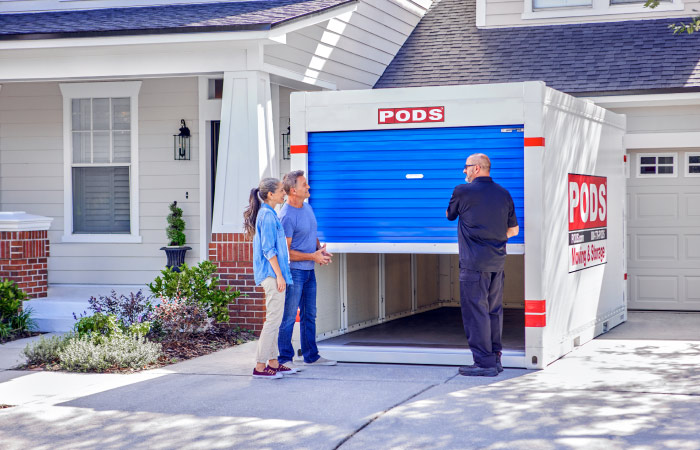
Moving Insurance Guide: How To Protect Your Property During a Move
Real Estate Advice
“Since moving puts your belongings at risk for all kinds of unforeseeable mishaps, having moving insurance might help protect against anything going awry,” says Jose Soto, a spokesman for State Farm.
Here are some frequently asked questions and answers about moving insurance — as well as additional tips for protecting your belongings — to keep in mind as you prepare for your move.
First, What Is the Meaning of Moving Insurance?
Moving insurance covers your belongings during transit, whether you’re relocating locally or embarking on a cross-country journey. It doesn’t matter if you're managing the move independently or hiring a moving company; this insurance protects your items while they're on the road. It's an additional layer of coverage offered by insurance companies, extending beyond the basic coverage provided by moving companies.
Should You Get Insurance When You Move?
Yes. “Most homeowners and renters insurance policies do not provide coverage for goods during the moving process, or the value insured is very limited, and that’s when moving insurance can help,” says Gadi Binness, president and CEO of the Relocation Insurance Group, which sells moving and storage insurance. Moving insurance can also help when moving companies don’t provide any insurance coverage or the coverage they offer doesn’t meet your needs.
Does Insurance Cover Moving Damages?
Even though they may not cover moving damage, you definitely still want to check your homeowners/renters and auto insurance policies before purchasing moving insurance coverage. “Call your insurance company to see how your coverage works. Everybody’s insurance policy is different,” says Lynne McChristian, spokesperson for the Insurance Information Institute, a non-profit organization representing the insurance industry. Here’s a breakdown of possible coverage for each:
Homeowners and Renters Insurance
Your policy might cover losses from such things as fire, theft, or vandalism during the move, but it might not cover damage if you drop your expensive flat-screen TV. “Most people don’t realize that homeowners or renters insurance may not cover loss or damage to your possessions when in transit,” says Soto from State Farm.
Auto Insurance
Soto also says your auto insurance policy typically provides only limited coverage if you transport your belongings in your car or a rental vehicle during a move.
What Are the Types of Moving Business Insurance?
Once you’ve checked on the coverage you already have, the next step is to ask your moving company what type of moving insurance coverage they offer. Always ask your moving company for details of the moving insurance policy you choose and review it in writing. You’ll also want to be clear about what’s covered and what’s not. Most policies require a detailed inventory of contents and their estimated values.
Here’s a quick look at a few types of coverage offered by full-service movers and portable container services:

Federal law requires movers to offer two kinds of movers liability insurance.
Coverage Offered by Full-Service Moving Companies
If you’re moving out of state, federal law requires movers to offer two kinds of movers liability insurance. Many companies also offer both types of coverage if you’re moving within a state. The two types of moving insurance required under federal law are:
Full Value Protection Moving Insurance
Think of full value protection as total movers liability insurance, meaning your moving company is responsible for the replacement value of any items damaged or lost during the move. The mover can offer to repair the item, replace it with a similar one, or offer a cash settlement that covers the cost of repairing or replacing the item at its current market value.
The price of full value protection varies, depending on the moving company and the deductible you choose. You must pay for this coverage in addition to the cost of the move itself.
Note that if you have valuable possessions such as jewelry or antiques, a moving company can limit its liability if something happens to those items, unless they are specifically listed on shipping documents. These items of “extraordinary value” are valued at more than $100 per pound.
Released Value Protection Moving Insurance
Think of released value protection as partial movers liability insurance. This moving insurance is included in the cost of the move, so you don’t pay extra for this type of coverage. However, the amount of coverage you receive is minimal. The movers liability insurance is no more than 60 cents per pound per article. That means if a 10-pound stereo component valued at $1,000 is damaged, you’ll receive just $6 in compensation. Yep. You read that right. You get what you pay for: There’s no extra charge and the coverage is basically worthless.
A traditional full-service mover may also offer separate liability coverage, which “fills the gap” between full value and released value protection, McChristian says. Under released value protection, the mover is liable for up to 60 cents per pound per article, but you can recoup the rest of the loss from the moving insurance company up to the limit of the policy you’ve purchased.
Separate Movers Liability Insurance
Some moving companies provide separate liability insurance, an optional add-on you can purchase. Regulated by state laws, this insurance covers the amount specified in your policy minus the basic carrier liability amount (up to 60 cents per pound) the mover pays. If you opt for this, ensure you receive a copy of your policy and fully comprehend your selected insurance amount and associated costs.

A container rental agreement with PODS requires that you have coverage for your belongings and for the container through PODS, your homeowners or renters insurance, or a third-party insurance company.
PODS’ Insurance Coverage Types
Moving container services such as PODS aren’t governed by the same federal laws as full-service movers. However, since accidents can occur, a container rental agreement with PODS requires that you have coverage for your belongings and for the container through PODS, your homeowners or renters insurance, or a third-party insurance company. Here are the two types of PODS insurance options:
Contents Protection
This PODS insurance option covers your belongings and the container if damage or loss occurs in situations such as accidents, vandalism, and burglary. However, damage caused by improper packing or normal shifting is not covered. An item is replaced based on the replacement cost of the item minus depreciation, which takes into account the age or the condition of the item. (See the Contents Protection Coverage Overview for more details.)
Even if your homeowners insurance covers your belongings when you’re using a moving container, you might want to consider PODS contents protection because the deductible is only $100, and you don’t have to file a claim against your homeowners insurance if your belongings are lost or stolen.
Container Only Protection
If your homeowners insurance covers your belongings, Container Only Protection covers loss or damage to the PODS container due to various causes, including fire, vandalism, or vehicle accidents.
Are There Other Moving Insurance Coverage Options?
If you think you need different moving insurance, you can also purchase a policy from an independent, third-party insurance company. Relocation Insurance Group, for example, offers different types of coverage depending on whether you’re using a full-service moving company, a mobile storage or portable container company, or a rental truck.
How Do You Calculate Moving Insurance Coverage?
To determine how much moving insurance you need, you should start by creating an inventory of your possessions, Binness says. That will give you a better idea of the value of the items you want to insure. You also need to decide if you want to insure all your possessions or only certain items. For instance, you might just want to insure your flat-screen TV and high-end dining set but not your 20-year-old, hand-me-down sofa. The cost of protecting your belongings during your move can vary significantly, depending on the type and amount of coverage, as well as the provider.

Damage caused by self-packing isn’t covered by moving insurance.
What Is Not Covered by Moving Insurance?
Moving insurance comes in handy for items not covered by homeowners or renters insurance, but that doesn’t mean it covers anything you want. As stated, there may be a cap on high-value items like jewelry, artwork, and antiques. There may also be no coverage offered at all on items that fall under one of these categories:
- Items you pack yourself: Trying to save money while moving by packing your own boxes? It’s a good budgeting strategy… unless you damage your items while packing them. If that’s the case, you’re the responsible party, not the moving company.
- Items damaged by fire or natural disasters: Sometimes the unexpected occurs during moves. If that’s the case, your moving company may have a clause stating that they’re not responsible for damages caused by Mother Nature or any other unforeseen Act of God.
- Perishable or hazardous items: Tell your moving company if they’re responsible for transporting your dangerous or perishable items. They may not be able to cover the items in any circumstance, but they definitely won’t cover them if they don’t know about them.
- Undisclosed high-value items: Like the items mentioned above, if you don’t disclose your high-value items before the move, you can’t ask the moving company to be financially responsible for them after the move. Good, thorough documentation is of the utmost importance!
Each state has its own liability and valuation requirements for movers. Now may be an opportune time to brush up on your state’s protocol before selecting a type of movers liability insurance.
Do I Still Need Moving Insurance If I Move Myself?
Are you planning a DIY move? You can still purchase additional third-party moving insurance, even if it’s not offered by or for a moving business. Here are some options to consider if you’re self-moving:
- Relocation or Transit Trip Insurance: This third-party insurance can cover your belongings, including damage to furniture sets or high-value items, mechanical and electrical accidents, mold, mildew, and natural disasters.
- Rental Truck Moving Coverage: If you're renting a truck, you're responsible for damages to the truck and your cargo. Some rental companies offer moving coverage, including cargo protection, damage waivers, medical and life insurance, supplemental liability coverage, and towing device insurance.

Take photos of your items and include them in your home inventory list.
More Tips on Moving Insurance and Protecting Your Belongings
While it’s impossible to eliminate all the risks during the moving process, here are a few ways to minimize loss and damage that are still under your control:
1. Take Photos and Document Your Belongings.
As with your homeowners and renters insurance, photos and documentation can help you during the claims process in the event of damage or loss. Photograph items before your move so you have proof of their pre-move condition, and document belongings by creating a moving inventory.
2. Keep Smaller Valuables With You.
Whether you choose to pay for extra moving coverage or not, it’s best to keep important and valuable items with you. This may include cash, expensive jewelry, laptops, important documentation, and family heirlooms. In fact, some providers may prohibit valuable items from being moved, so be sure to review your contract.
3. Pack and Prepare Items With Care.
Use proper boxes and packing materials. There are specially made boxes to protect specific items such as TVs and fine china. Use shrink wrap and moving blankets to protect furniture. And to avoid mildew spreading throughout your belongings, make sure everything is totally dry and free of existing mildew before loading. These tips will help you pack and load like a pro.
4. Ask About Transit Details.
Did you know that many full-service movers end up loading and unloading your stuff multiple times during the transportation process? For long-distance moves, it’s common for traditional movers to mix your belongings with those of other customers to fill larger transport trucks, which increases the risk of damage or loss. In comparison, portable containers hold only your possessions, and they’re only loaded and unloaded once by you or helpers you hire.
When you’re preparing to move, take time to check out the moving insurance options available, and ask questions to make sure you get the right coverage for your needs. For more tips on planning your move, see 12 Things To Consider Before Hiring Cross-Country Movers and Watch Out for These Hidden Costs of Moving.
Susan Ladika is a freelance writer based in Tampa who specializes in writing about personal finance, insurance, and banking topics.
Related Articles
Comments
Leave a Comment
Your email address will not be published. Required fields are marked *
